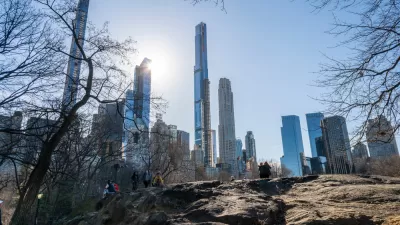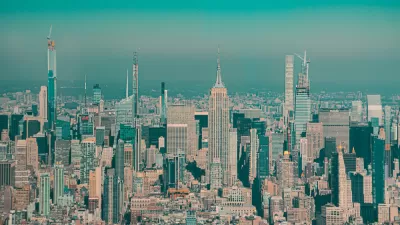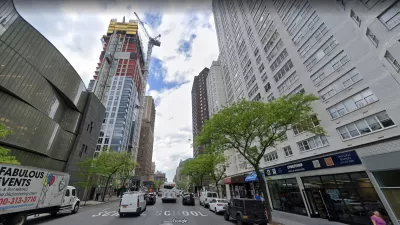If you never knew, or thought you knew, the reason why there are no skyscrapers in the middle of the Big Apple, Matt Chaban reports on the true cause, debunking a popular myth.
Popular lore had it that the bedrock sitting just below the surface of much of the island, and providing the ideal foundation for tall buildings, falls away in its "gooey middle": thus no skyscrapers.
Not so says Chaban, reporting on the results of a recent study that appeared in The Journal of Economic History, debunking the "Manhattan bedrock myth." "Using 173 random core samples from the Battery to Central Park South, Mr. [Jason] Barr, Troy Tassier and Rossen Trendafilov were able to show that there was no correlation between the depth of bedrock and the likelihood of a skyscrapers construction..."
The authors hypothesize that the true cause of the skyline dip is "not an issue of supply, of where you can build. It's an issue of demand, or where you want to build."
FULL STORY: Uncanny Valley: The Real Reason There Are No Skyscrapers in the Middle of Manhattan

Alabama: Trump Terminates Settlements for Black Communities Harmed By Raw Sewage
Trump deemed the landmark civil rights agreement “illegal DEI and environmental justice policy.”

Planetizen Federal Action Tracker
A weekly monitor of how Trump’s orders and actions are impacting planners and planning in America.

The 120 Year Old Tiny Home Villages That Sheltered San Francisco’s Earthquake Refugees
More than a century ago, San Francisco mobilized to house thousands of residents displaced by the 1906 earthquake. Could their strategy offer a model for the present?

Indy Neighborhood Group Builds Temporary Multi-Use Path
Community members, aided in part by funding from the city, repurposed a vehicle lane to create a protected bike and pedestrian path for the summer season.

Congestion Pricing Drops Holland Tunnel Delays by 65 Percent
New York City’s contentious tolling program has yielded improved traffic and roughly $100 million in revenue for the MTA.

In Both Crashes and Crime, Public Transportation is Far Safer than Driving
Contrary to popular assumptions, public transportation has far lower crash and crime rates than automobile travel. For safer communities, improve and encourage transit travel.
Urban Design for Planners 1: Software Tools
This six-course series explores essential urban design concepts using open source software and equips planners with the tools they need to participate fully in the urban design process.
Planning for Universal Design
Learn the tools for implementing Universal Design in planning regulations.
Clanton & Associates, Inc.
Jessamine County Fiscal Court
Institute for Housing and Urban Development Studies (IHS)
City of Grandview
Harvard GSD Executive Education
Toledo-Lucas County Plan Commissions
Salt Lake City
NYU Wagner Graduate School of Public Service





























